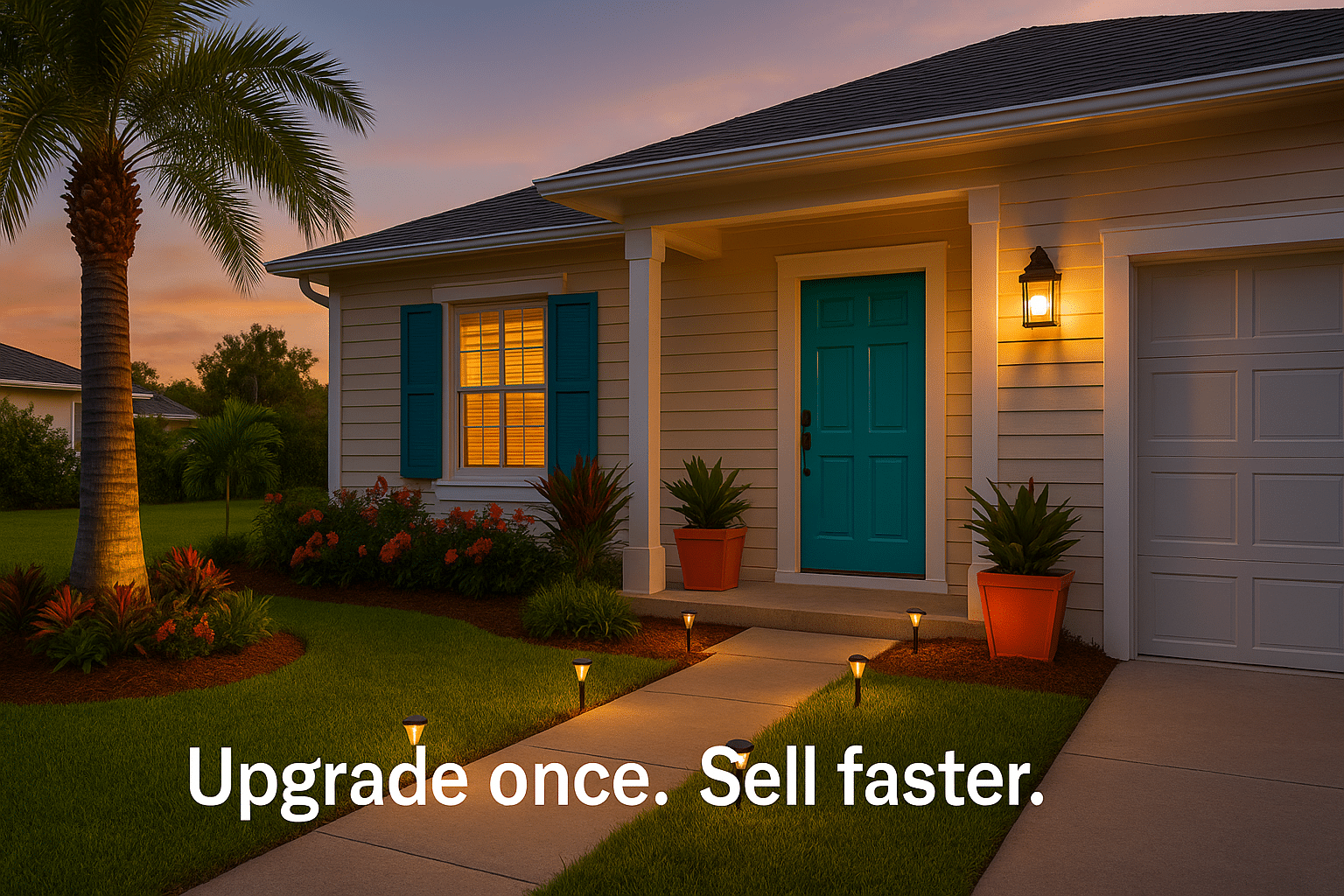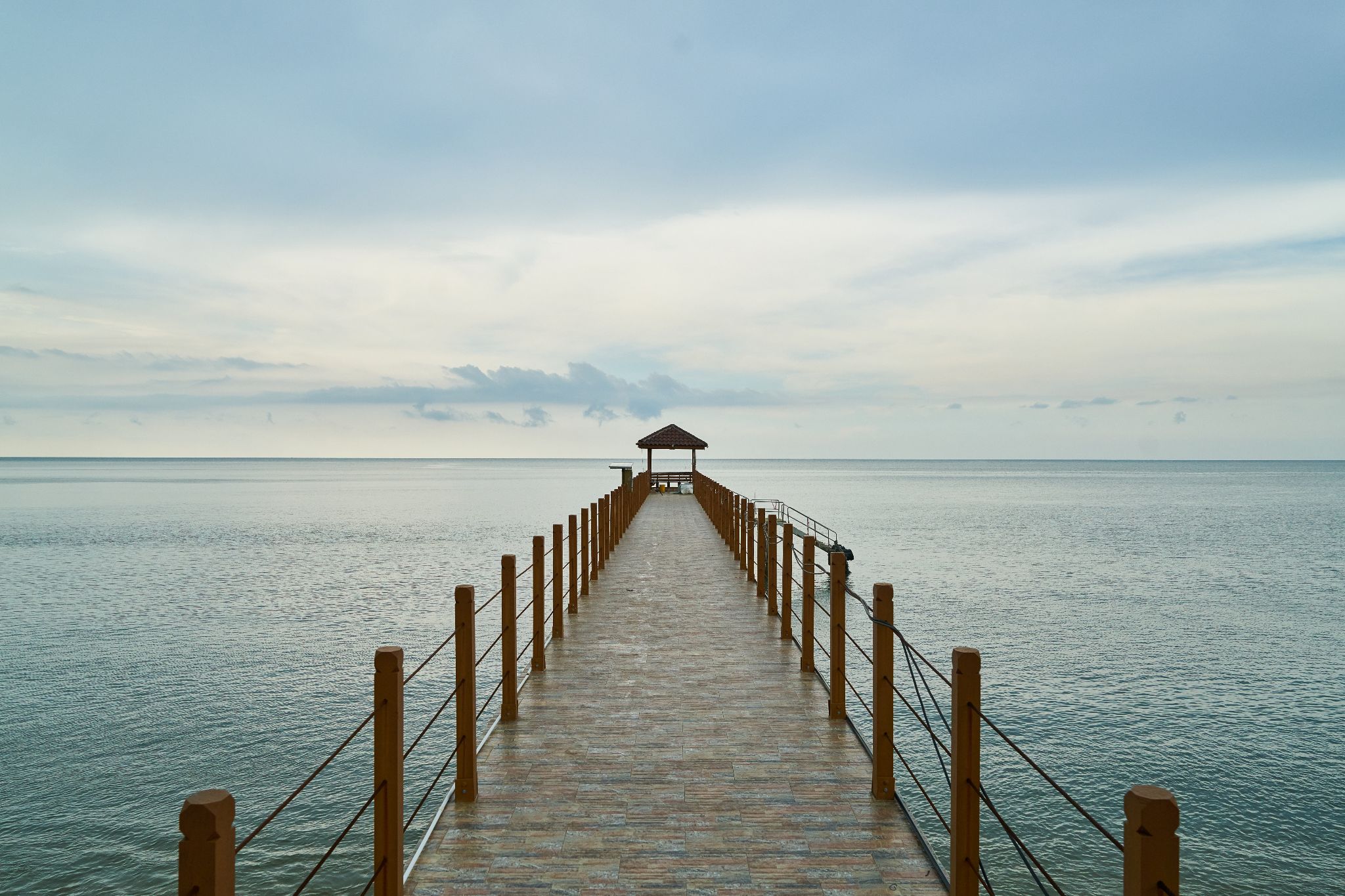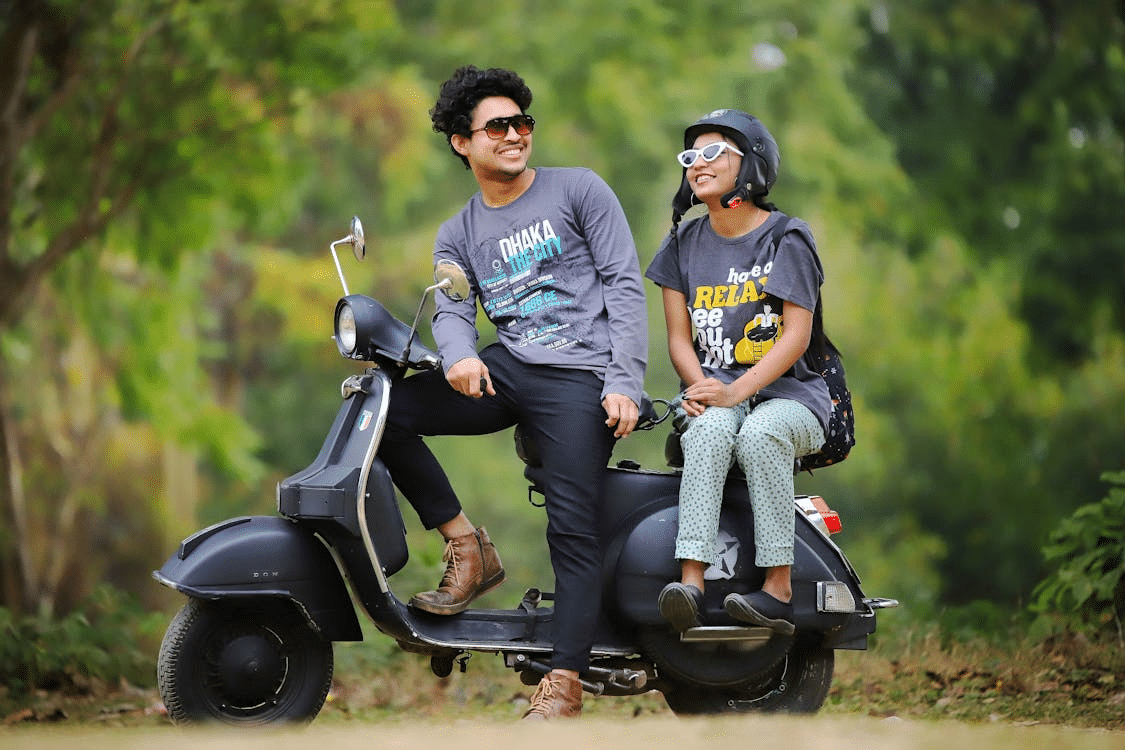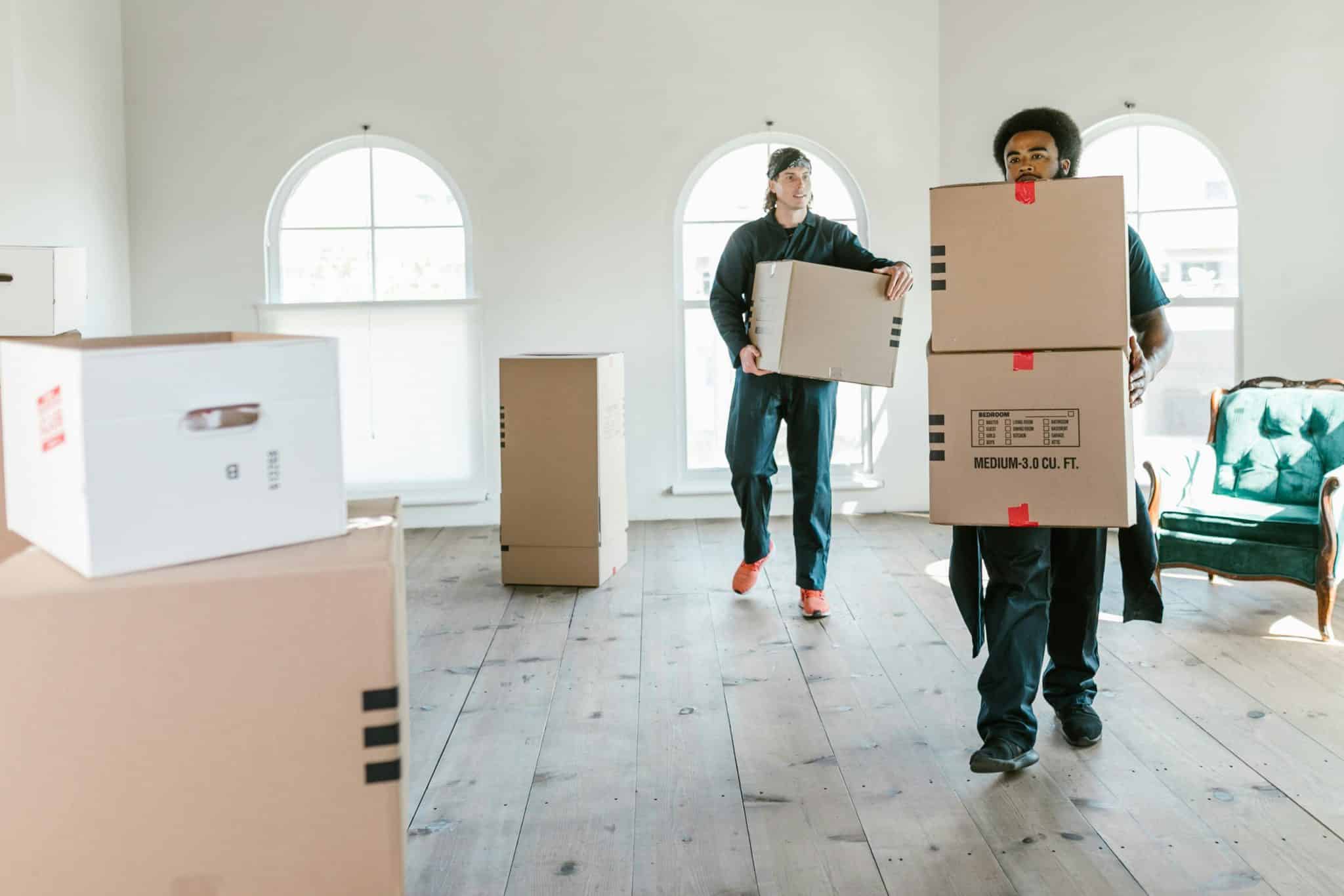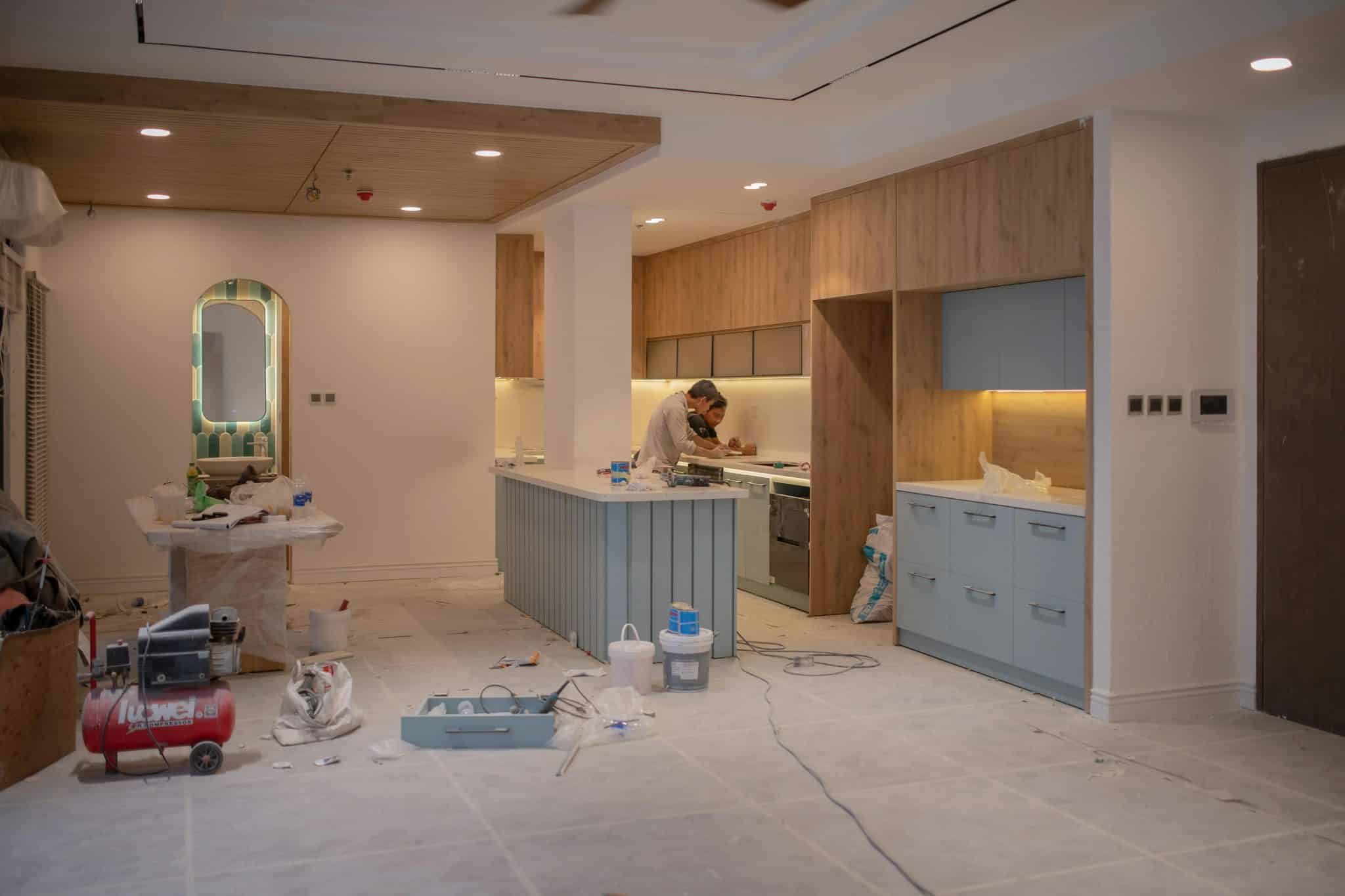Florida’s 2025 coastal market moves fast. New listings hit the MLS every hour, and buyers judge a home in eight seconds—the blink it takes to scan one thumbnail. Show them a cared-for porch with fresh paint, trimmed palms, and impact-rated accents, and they’ll tap instead of scroll.
That tap becomes a showing; showings spark offers. The eight curb-appeal upgrades ahead are quick, wallet-smart projects built for Florida’s salt, sun, and storm code. Begin with one this weekend, or combine a few for a stronger first impression, and your home could sell sooner.
Why First Impressions Matter In Florida’s 2025 Market
Curb appeal is more than just eye candy — it’s a smart investment for you. Buyers decide in seconds, so every detail counts. Agents agree: 51% say outdoor upgrades boost buyer interest. A study found well-kept homes sold for 5.5–12.7% more. These first impressions often mean faster sales and stronger offers. Florida Realtors note sellers often get above-asking bids — great curb appeal helps lock in that premium.
- Well-maintained outdoor areas add roughly 15% to perceived home value (about $60K on a $400K home) and can yield ~12% higher sale prices
- A new steel front door nets ~188% ROI (roughly $4.4K value on a $2.3K spend)
- A new garage door yields 194% ROI ($8.7K back on $4.5K investment)
- Top-tier curb appeal can boost sale price by ~5–13%, often attracting multiple above-ask bids
Zillow notes even simple curb upgrades pay off: homes with basic yard updates sold ~2% faster and for a small premium. In short, great first impressions drive listing performance and offer strength. NAR finds perfect presentation (think staging + curb appeal) can lift the final price by ~10%. In Florida’s market, that means higher bids and a quicker sale.
The upgrades below focus on quick, budget-aware moves that fit Florida’s sun, salt, and hurricane code. Handle one or stack them all, and watch your curb invite the right offer sooner.
Tropical Planting That Pays For Itself
Tropical planting instantly frames your lawn with color and height while shrugging off Florida heat and humidity.
Start by patching bare grass, edging the walk, and spreading a fresh two-inch (5 cm) blanket of pine-straw mulch—the clean border pops in photos and runs under $100.
Next, add low-maintenance bloomers. Hibiscus, crotons, and bird-of-paradise flowers for months without daily watering, while two young foxtail palms flanking the entry give instant stature. Think in threes: three vivid shades (lime, coral, emerald) and three layers (ground cover, waist-high shrubs, head-high palms) create depth that flat lawns lack.
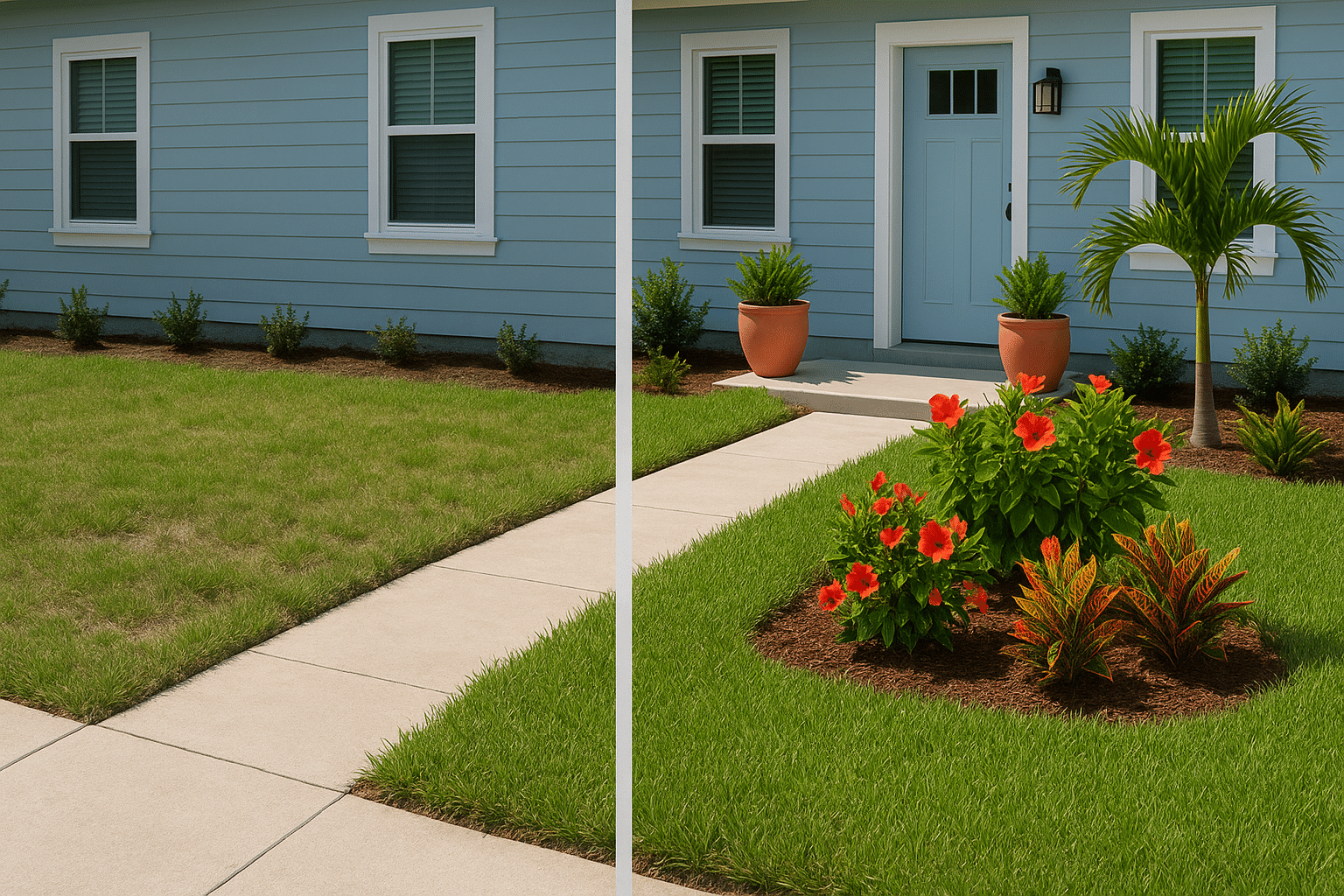
Finish with one coastal teal planter on each front corner. The pottery ties your door color to the plant palette and pulls the eye straight to the porch. According to the 2024 Florida Realtors Remodeling Impact Report, a professional yard refresh typically recoups 100 percent of its resale cost, so every dollar you plant today comes back at closing.
A Front Door That Welcomes And Protects
A front door is the first detail buyers touch, and they remember that feel long after scrolling.
Choose a unit that looks sharp, blocks wind, and boosts insurance confidence in one move.
The four upgrades below take a single afternoon and cost less than most price cuts.
- Refresh the color. Roll on a quart of high-gloss exterior paint in turquoise, coral, or deep navy. One coat (≈ $35, covers 80 ft²) dries in four hours under 85°F sun, and a second coat the next morning deepens the shine without peeling in salt air.
- Swap the hardware. Trade pitted brass for a 316-grade stainless set. Budget $80–$120 for a handle, strike plate, and Wi-Fi smart lock that lets agents trigger code-based entry, so showings stay on schedule. Stainless resists corrosion for up to 15 years, a fact worth citing in remarks.
- Upgrade the slab if needed. If the door is warped or leaks light, choose a fiberglass model rated +60 / –60 psf under the 2024 Florida Building Code. A 36 × 80-in slab plus install runs $1,600–$2,400 in 2025. Listing “impact-rated door” can shave 5–8 percent off wind premiums.
- Layer finishing touches. Mount twin LED lanterns (2700 K, dusk-to-dawn) at eye height, unroll a coir mat trimmed to 30 × 48 in, and align both fixtures so the eye flows to the threshold. Total add-on cost: ≈ $110.
Complete all four steps for under $2,700, and you create a crisp thumbnail that earns more taps, longer tours, and firmer offers.
Night-Ready Lighting That Turns Heads After Dusk
Evening photos live online forever, so your exterior needs to glow long after the sun drops behind the palms. Good lighting also deters drive-by doubts: shoppers trust a home that looks secure at 9 pm. Use these four moves to earn those clicks and calm nerves.
- Line the walk with solar stakes. Set six 15-lumen posts (≈ $6 each) 24 in / 60 cm apart along the main path. Built-in dusk-to-dawn sensors create a soft, even ribbon of light without trenching wire or adding to the power bill. Install time: 20 minutes.
- Replace tired sconces. Swap corroded brass for salt-proof matte-black lanterns, each fitted with a 2700 K LED rated 800 lumens. A matching pair plus bulbs runs $140–$220 in 2025. The warm temperature flatters stucco and photographs richer than cool white.
- Aim two low-voltage spots. Position a pair of 4-watt LED uplights (≈ 300 lumens each) to skim a palm trunk or textured wall. Angled beams highlight depth that daylight hides and draw the camera lens toward your entry. Expect $60–$80 for fixtures and wire.
- Sync everything with a smart timer. Plug all circuits into a $25 outdoor Wi-Fi socket programmed for 6 pm–11 pm. Automated control keeps lights in unison, saves roughly 70 percent on energy versus halogen, and lets you adjust schedules from your phone.
Finish this checklist in one weekend for about $350, and nighttime curb appeal will shine brighter, feel safer, and help secure stronger offers.
Pressure-Wash And Paint Touch-Ups For An Instant Lift
Salt-laden breezes turn bright stucco beige and streak concrete with algae in only a season or two. Luckily, buyers scrolling local platforms like Palm Beach County homes for sale can spot the difference after a single weekend of pressure-washing and one quart of matching paint. Follow the steps below to restore a photo-ready façade that boosts clicks and calms inspectors.
- Blast the hardscape. Rent a 2,800-PSI washer for about $85 a day. Start on the driveway, then sweep the nozzle across the front walk. Gray concrete reappears as algae, rust, and tire marks lift away; average cleaning time for a 1,000-ft² slab is 40 minutes.
- Soft-wash the walls. Swap to a 40-degree fan tip and stand 24 in (60 cm) from the stucco. Keep pressure below 1,200 PSI to remove mildew without peeling paint. One slow pass restores trim contrast and brightens the entire color field. If stubborn discoloration lingers, a quick wall painting in a UV-stable coastal hue can brighten listing photos and shield the stucco for seasons to come.
- Touch up the trim. Let surfaces dry for two hours of midsummer sun, then roll two thin coats of exterior acrylic over porch posts, fascia, and doorframes. One quart—about $28—covers 80 ft² and hides hairline cracks that telegraph neglect in listing photos.
- Inspect and seal gaps. Walk the perimeter with a 10-oz tube of paintable latex caulk and fill joints around windows, vents, and light boxes. This ten-minute step blocks wind-driven rain and signals proactive maintenance to buyers.
With less than $120 in supplies, you’ll finish before Sunday dinner and unveil a fresh, bright exterior that photographs better, attracts more showings, and proves the home is well-kept.
Small Details That Clinch Confidence
First impressions live in inches. When a mailbox leans or digits fade, buyers wonder what larger chores lurk inside. Spend a modest afternoon correcting these micro-flaws, and you replace doubt with trust. Each step below draws on USPS and Florida code rules that will satisfy inspectors.
- Straighten the mailbox. USPS sets the ideal height at 41–45 in (104–114 cm) and requires the door to sit 6–8 in (15–20 cm) from the curb. A powder-coated steel box and treated pine post cost $65–$110 installed in 2025. Anchor the post in 50 lb of fast-setting concrete; it cures in 30 minutes and shrugs off summer downpours.
- Swap in bold house numbers. Visible identification speeds emergency crews and delivery vans. Choose 5-in (13 cm) matte-black aluminum digits with reflective film rated ASTM D4956 Type I. Mount them 1 in apart on a 6-in cedar plaque sealed with marine varnish. Hardware kit plus numbers runs about $22, and the contrast pops in listing photos shot at dusk.
- Tighten door hardware. A rattling handle tells buyers that maintenance lags. Swap to a 316 stainless lever set with a Grade 2 ANSI BHMA security rating. Expect $80–$140 for the kit, screwdriver included. Apply blue thread-locker on the screws, then torque to 30 in-lb; the solid feel during showings whispers quality.
- Polish and edge. Finish by buffing metal with a citrus solvent and microfiber rag until water beads. Brush a two-inch (5 cm) collar of pine-straw mulch around the post and along the front walk. The crisp edge creates a visual arrow toward the door and reduces weed growth by up to 80 percent for six weeks.
Stage The Porch As An Outdoor Room
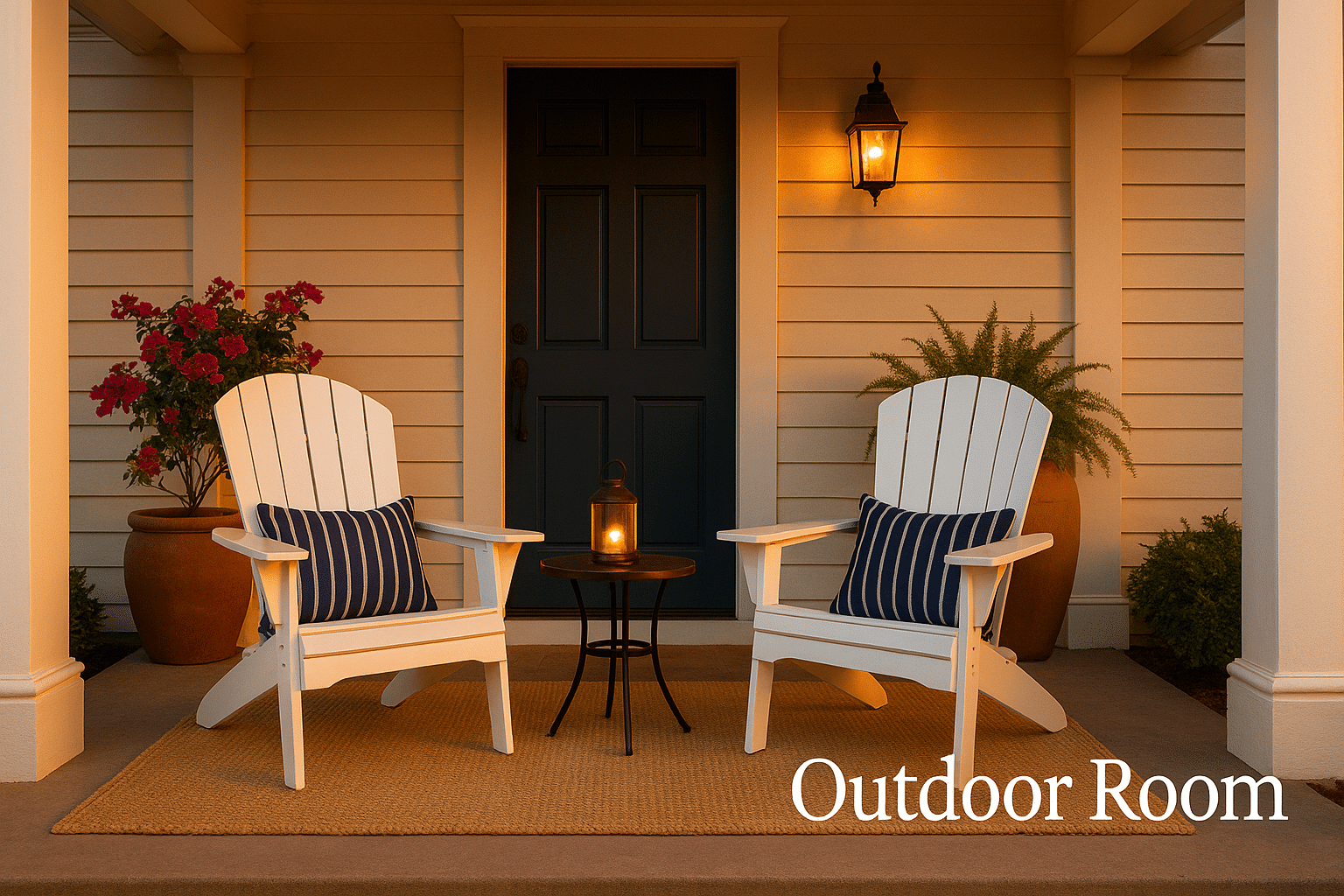
A styled porch tells buyers your home offers extra living space before they even step inside. By furnishing it with weather-ready pieces, you transform square footage that once felt decorative into an asset that photographs like an additional room. The change invites longer tours, because visitors pause to imagine coffee mornings or sunset chats. It also signals thoughtful upkeep, reassuring buyers that the same care runs through the rest of the house.
- Anchor seating for conversation. Angle two Adirondack chairs 15° toward the street and space them 22 in (56 cm) apart around a 30-in (76-cm) bistro table. This relaxed “V” signals welcome in photos and costs $230–$260 for a resin pair and powder-coated table.
- Add soft surfaces. Slip 24 × 16-in (61 × 41 cm) navy-striped cushions over each seat and roll out a 5 × 7-ft (1.5 × 2.1 m) sisal rug. Textiles soften shadows and dampen shuffle noise during showings. Plan on about $95 for both.
- Keep air moving. Mount a damp-rated 52-in ceiling fan delivering 4,500 CFM on low speed. Steady airflow tames July humidity and lengthens visitor dwell time. Fan plus installation averages $180 in 2025.
- Frame the entry with greenery. Position two 18-in (46 cm) ceramic pots beside the door; combine bougainvillea for color and a foxtail fern for texture. Matched height “bookends” your entry and guide eyes to the handle. Plants and pots run roughly $60. Select pot glazes that echo your front-door color for cohesive, subtle harmony. Place a cordless lantern there for evening ambience and mood.
- Reset before each viewing. Sweep leaves, slide parcels into a deck box, and stack beach toys in a woven bin. A clear floor reads larger and lets the camera capture full depth.
According to a 2024 Zillow Consumer Housing Trends Report, patios and porches styled as outdoor rooms raise perceived usable area by 7 percent, extending average tour length by two minutes. Longer linger time gives agents space to highlight energy upgrades and reinforces the impression that the home is ready to enjoy from day one.
Bahama Shutters: Coastal Style With Hurricane Muscle
Bahama shutters give your windows a laid-back Key West look while meeting the same hurricane standards as thick plywood panels. Because each panel tilts out on top hinges, you enjoy constant shade and cross-breezes during calm weather. When a tropical warning arrives, you swing the shutters down, latch the four corners, and the glass is shielded in minutes. That blend of beauty, comfort, and safety makes impact-rated Bahama shutters a standout in Florida’s 2025 coastal market.
- Pick code-rated panels. Order extruded-aluminum shutters stamped +140/-150 psf under the 2024 Florida Building Code. A common 36 × 54-inch unit costs 490 to 620 dollars installed in 2025, including stainless hinges and locking pins.
- Match the finish to your facade. Factory powder-coating comes in more than 150 shades. Choose pale coral, sea-foam green, or a tone that echoes the front door; the visual harmony lifts listing photos and keeps the screws hidden from curb view.
- Mount for shade and speed. Install hinges six inches above the top jamb so louvers rest at a thirty-degree angle when propped open. This tilt drops indoor temperatures by up to five degrees Fahrenheit, trims sun fade on flooring, and still lets rain sheet away. Closing a pair takes under three minutes once the storm alert pings your phone.
- Advertise the financial upside. Add the line “impact-rated Bahama shutters installed 2025” to the MLS remarks. Many insurers reduce wind premiums by five to seven percent for code-compliant shutters, and the My Safe Florida Home grant reimburses as much as ten thousand dollars on qualifying projects. Mention both incentives during showings to reassure budget-minded buyers.
Outfitting the four street-facing windows runs about $2,000 yet delivers curb appeal, lower bills, and a hurricane-ready storyline that nudges offers higher. That cost-to-trust ratio is one of the best among Florida curb-appeal projects, according to 2024 statewide remodeling impact surveys.
Impact-Rated Windows And Doors Earn Instant Trust
Most buyers zoom in on window frames before they notice flooring or paint. If they spot foggy, thin glass, they picture hurricane deductibles, soaring power bills, and rattling street noise. Show them modern impact units instead, and you advertise safety, silence, and sunshine in one glance. You also satisfy the insurer’s wind-mitigation inspection that now blocks many coastal closings across Florida.
- Choose assemblies that pass the 2024 code. Select products tested at +50 / –50 psf, Large Missile Level D, and fitted with low-e laminated panes. A 72 × 60 in (183 × 152 cm) slider runs $1,550–1,900 installed in 2025, while a 36 × 54 in (91 × 137 cm) single-hung costs 680–820. Insist on a U-factor ≤ 0.30 and SHGC ≤ 0.25 to shrink cooling loads.
- Match frames to existing hardware. Powder-coated aluminum or fiberglass frames, finished in dark bronze, resist salt spotting between washings and echo porch lanterns for photo harmony. Color-matched fasteners hide screw heads, a detail inspectors and appraisers both note.
- Leverage the financial stack. The My Safe Florida Home grant can reimburse up to $10,000 on qualifying openings, and most carriers shave wind premiums by 8–11 percent once you file the completion certificate. PACE loans spread any remaining balance over property taxes with no money down, easing cash flow.
- Highlight everyday comfort. Laminated glass blocks 99 percent of UV, trims midday interior temperatures by ≈ 3 °F (1.7 °C), and raises sound-transmission class from STC 27 to STC 35, quieting lawn-mower roar. Share those numbers at showings to shift the talk from cost to daily benefit.
Outfitting a three-panel slider and two street-facing windows averages $6,200–7,100, yet delivers lower energy bills, reduced insurance, and a hurricane-ready headline that can cut days on market. Redfin data from late-2024 shows listings tagged “2024-code impact glass” closed seven days faster on average, proof that this upgrade pays back in speed as well as safety.
A Roof Buyers Read Like A Headline
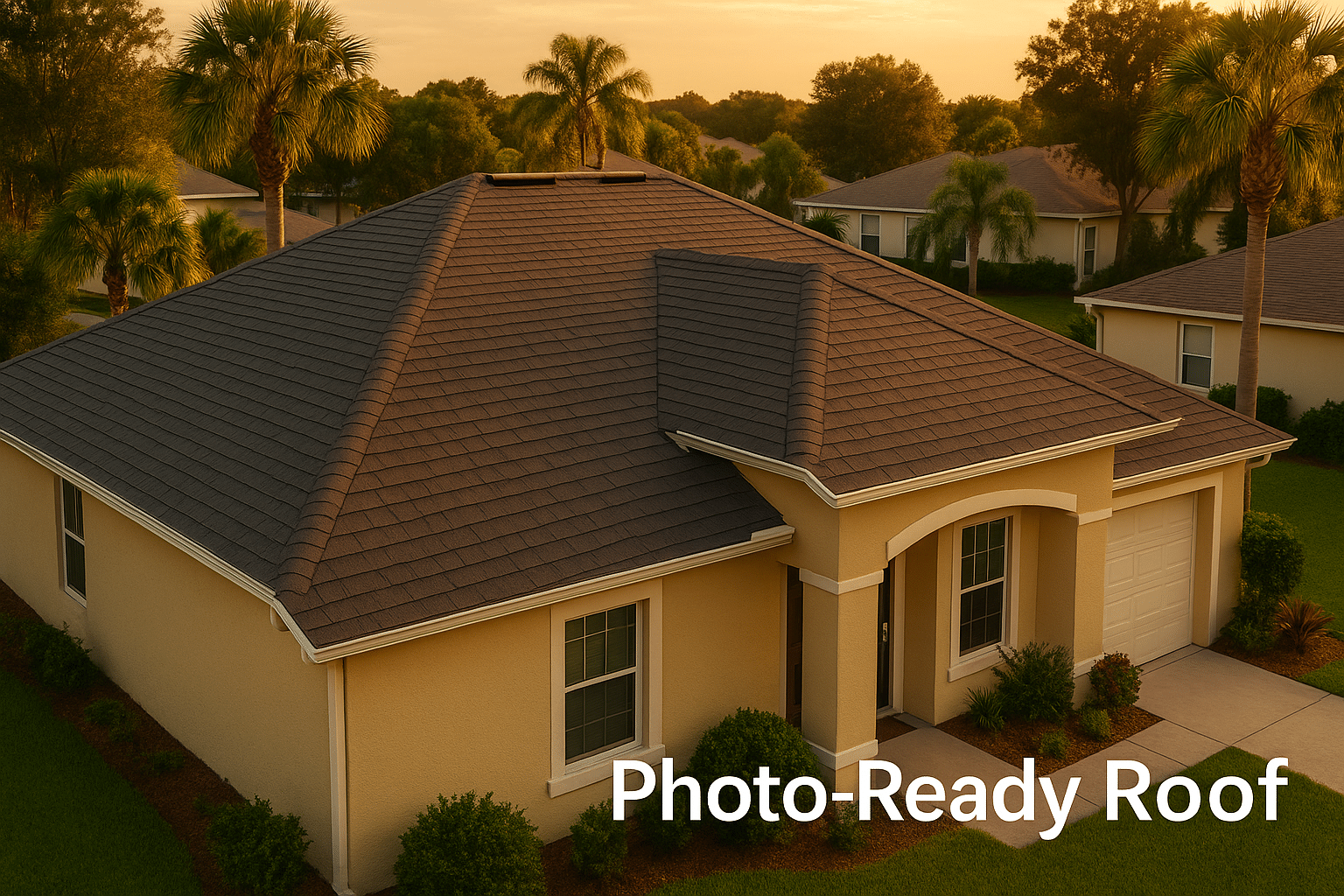
Your roof tells buyers and insurers whether the rest of the house is trouble-free or ticking toward a claim. A clean, code-rated surface whispers “low risk,” but a faded shingle shouts repair bills. Treat the overhead view as marketing real estate, not background scenery.
- Verify age, pitch, and paperwork. Pull the permit card or invoice to nail down the install date; lenders want proof in writing. Asphalt that has baked through 15 Florida summers or metal that has weathered 30 triggers extra wind-mitigation scrutiny under the 2024 Florida Building Code. If you sit inside those windows, gather recent inspection photos or a replacement quote, so buyers stay calm instead of calculating discounts.
- Restore a sound roof with a soft wash. Roofs well within the age limit usually need cleaning, not replacement. Hire a licensed crew to apply a 3 percent sodium-hypochlorite mix at 60–80 psi. Two technicians finish a 2,200-ft² roof in about two hours for $340–$420 in 2025. The rinse dissolves algae streaks, brightens the ridge line, and can raise online photo click-through by double digits.
- Replace when function slips. If granules collect in gutters or panels show corrosion, step up to material that raises appraisal value. Architectural shingles rated 130 mph cost $6.20–$7.10 per ft² installed; Galvalume standing-seam panels rated 180 mph run $9.00–$11.00. Both must include peel-and-stick underlayment plus a secondary cap sheet—the dual-layer Florida adopted in 2024. Note “2024-code roof” in the MLS remarks to satisfy underwriters before the first showing.
- Package the warranty and savings. A manufacturer’s limited-lifetime shingle warranty or 40-year metal finish warranty trims risk on paper and in buyer psychology. Carriers typically shave 6–9 percent off wind premiums on roofs installed after July 2024. Quote that ranges during tours so the upgrade feels like a monthly credit, not a sunk cost. Add ridge vents or solar-ready flashing if you want another talking point; both improve resale math for less than $1,000.
Expect to invest $14,000–$17,000 on a 2,200-ft² replacement, yet Zillow data from late 2024 shows listings tagged “new roof” closed eight days sooner on average. That time-saved dividend often eclipses the final invoice, making a compliant, photo-ready roof one of Florida’s highest-ROI curb-appeal projects.
Finishing Touches That Close The Story
When the paint is dry and the porch is staged, a last curbside sweep can elevate first impressions from good to remarkable. Buyers decide in eight seconds whether to click a listing, so every stray shadow or off-center pot matters. Your goal is to present one balanced, uncluttered image that suggests careful ownership without looking forced. Follow this five-step micro-audit on photo day and again an hour before each showing, and you knit every earlier upgrade into a single, polished narrative that invites tours.
- Balance the color field. Stand on the street and snap a phone photo. If one side carries all the bloom, slide a 12-in (30 cm) terra-cotta pot of coral geraniums to the lighter edge. Pot, soil, and plant total ≈ $18 and restore visual weight in under five minutes.
- Remove visual noise. Roll trash bins behind the gate, park cars at least two houses down, and coil garden hoses flat against the wall. A 2024 Zillow study showed clutter-free facades earned 9 percent more listing clicks than similar homes, reinforcing these DIY home staging tips.
- Center the vista lines. Trim branches that interrupt the roof slope, then angle porch chairs so their inside arms point directly to the door. Leave 6 in (15 cm) between chair legs and table edges to create breathing space that reads larger in photos.
- Polish every metal accent. Buff handles, knockers, and lantern caps with a microfiber cloth and citrus solvent until water beads. Shining metal reflects light toward the camera sensor, adding a subtle sparkle that boosts perceived cleanliness.
- Add one coastal accent. Choose a single detail under $25—a rope-handled lantern, a brass pineapple door knocker, or a navy flag trimmed to 24 in (61 cm) wide. One memorable note lodges your home in a shopper’s mind without tipping into theme-park décor.
The entire checklist costs under $75 and takes less than an hour, yet it can lift click-through rates and in-person dwell time enough to protect your asking price in Florida’s competitive 2025 market.
Conclusion: Invest Once, Sell Faster
Each of the ten DIY projects in this guide delivers more than a tidy porch or bright walkway; together, they build a story of a home that is easy to own. Start with the task that fits your weekend and budget—whether that is swapping a front-door handle or lining the walk with solar stakes—and record your current click-through and showing counts.
As you complete more upgrades, watch those metrics climb; top agents report that well-lit entries alone can double week-one showings. A small outlay of $340–$2,000 per project can protect far more equity than any price cut. Choose, act, and meet buyers with confidence.

